keyless JEEP CHEROKEE 2019 Owner handbook (in English)
[x] Cancel search | Manufacturer: JEEP, Model Year: 2019, Model line: CHEROKEE, Model: JEEP CHEROKEE 2019Pages: 344, PDF Size: 6.35 MB
Page 56 of 344
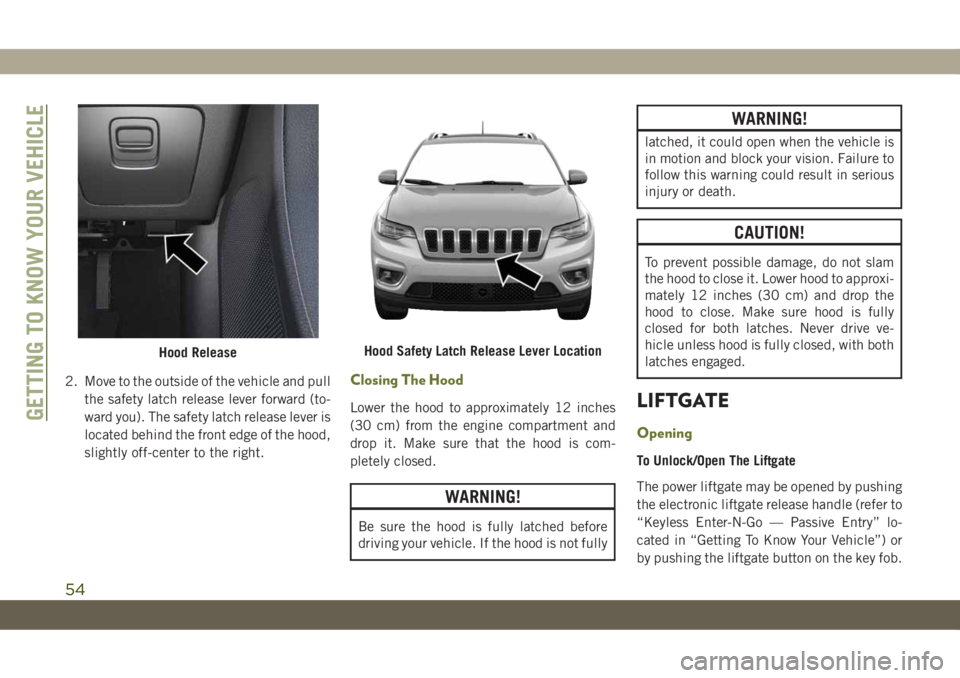
2. Move to the outside of the vehicle and pull
the safety latch release lever forward (to-
ward you). The safety latch release lever is
located behind the front edge of the hood,
slightly off-center to the right.Closing The Hood
Lower the hood to approximately 12 inches
(30 cm) from the engine compartment and
drop it. Make sure that the hood is com-
pletely closed.
WARNING!
Be sure the hood is fully latched before
driving your vehicle. If the hood is not fully
WARNING!
latched, it could open when the vehicle is
in motion and block your vision. Failure to
follow this warning could result in serious
injury or death.
CAUTION!
To prevent possible damage, do not slam
the hood to close it. Lower hood to approxi-
mately 12 inches (30 cm) and drop the
hood to close. Make sure hood is fully
closed for both latches. Never drive ve-
hicle unless hood is fully closed, with both
latches engaged.
LIFTGATE
Opening
To Unlock/Open The Liftgate
The power liftgate may be opened by pushing
the electronic liftgate release handle (refer to
“Keyless Enter-N-Go — Passive Entry” lo-
cated in “Getting To Know Your Vehicle”) or
by pushing the liftgate button on the key fob.
Hood ReleaseHood Safety Latch Release Lever Location
GETTING TO KNOW YOUR VEHICLE
54
Page 58 of 344
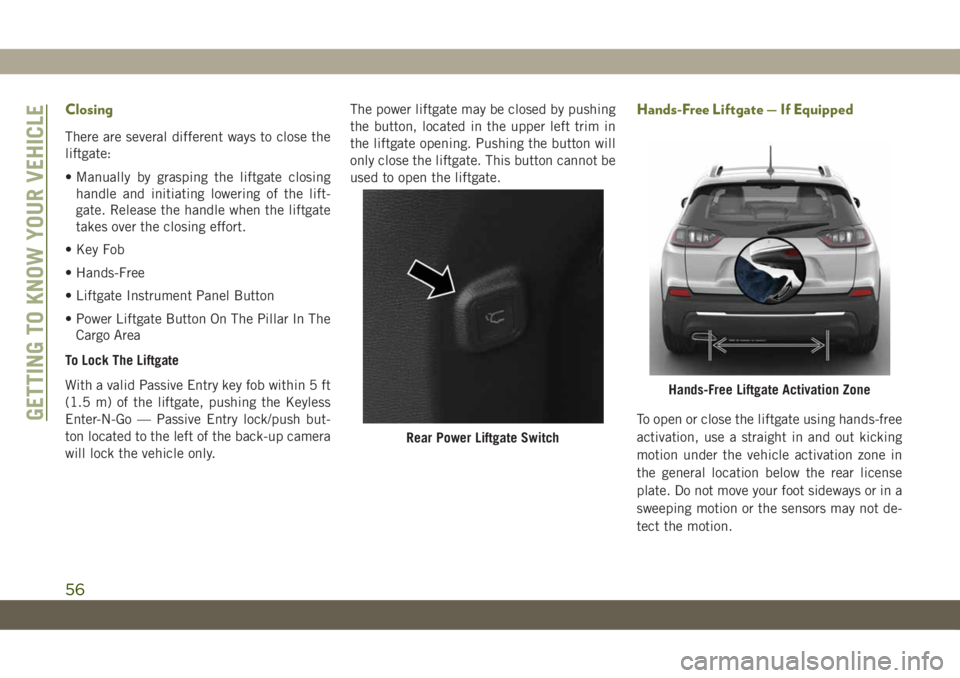
Closing
There are several different ways to close the
liftgate:
• Manually by grasping the liftgate closing
handle and initiating lowering of the lift-
gate. Release the handle when the liftgate
takes over the closing effort.
• Key Fob
• Hands-Free
• Liftgate Instrument Panel Button
• Power Liftgate Button On The Pillar In The
Cargo Area
To Lock The Liftgate
With a valid Passive Entry key fob within 5 ft
(1.5 m) of the liftgate, pushing the Keyless
Enter-N-Go — Passive Entry lock/push but-
ton located to the left of the back-up camera
will lock the vehicle only.The power liftgate may be closed by pushing
the button, located in the upper left trim in
the liftgate opening. Pushing the button will
only close the liftgate. This button cannot be
used to open the liftgate.
Hands-Free Liftgate — If Equipped
To open or close the liftgate using hands-free
activation, use a straight in and out kicking
motion under the vehicle activation zone in
the general location below the rear license
plate. Do not move your foot sideways or in a
sweeping motion or the sensors may not de-
tect the motion.
Rear Power Liftgate Switch
Hands-Free Liftgate Activation Zone
GETTING TO KNOW YOUR VEHICLE
56
Page 141 of 344
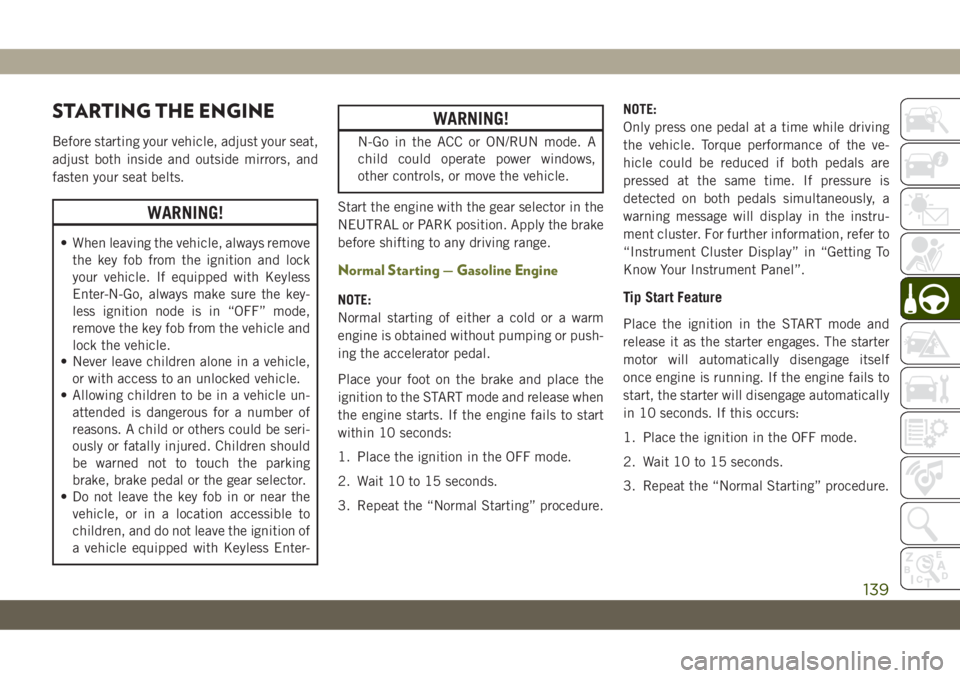
STARTING THE ENGINE
Before starting your vehicle, adjust your seat,
adjust both inside and outside mirrors, and
fasten your seat belts.
WARNING!
• When leaving the vehicle, always remove
the key fob from the ignition and lock
your vehicle. If equipped with Keyless
Enter-N-Go, always make sure the key-
less ignition node is in “OFF” mode,
remove the key fob from the vehicle and
lock the vehicle.
• Never leave children alone in a vehicle,
or with access to an unlocked vehicle.
• Allowing children to be in a vehicle un-
attended is dangerous for a number of
reasons. A child or others could be seri-
ously or fatally injured. Children should
be warned not to touch the parking
brake, brake pedal or the gear selector.
• Do not leave the key fob in or near the
vehicle, or in a location accessible to
children, and do not leave the ignition of
a vehicle equipped with Keyless Enter-
WARNING!
N-Go in the ACC or ON/RUN mode. A
child could operate power windows,
other controls, or move the vehicle.
Start the engine with the gear selector in the
NEUTRAL or PARK position. Apply the brake
before shifting to any driving range.
Normal Starting — Gasoline Engine
NOTE:
Normal starting of either a cold or a warm
engine is obtained without pumping or push-
ing the accelerator pedal.
Place your foot on the brake and place the
ignition to the START mode and release when
the engine starts. If the engine fails to start
within 10 seconds:
1. Place the ignition in the OFF mode.
2. Wait 10 to 15 seconds.
3. Repeat the “Normal Starting” procedure.NOTE:
Only press one pedal at a time while driving
the vehicle. Torque performance of the ve-
hicle could be reduced if both pedals are
pressed at the same time. If pressure is
detected on both pedals simultaneously, a
warning message will display in the instru-
ment cluster. For further information, refer to
“Instrument Cluster Display” in “Getting To
Know Your Instrument Panel”.Tip Start Feature
Place the ignition in the START mode and
release it as the starter engages. The starter
motor will automatically disengage itself
once engine is running. If the engine fails to
start, the starter will disengage automatically
in 10 seconds. If this occurs:
1. Place the ignition in the OFF mode.
2. Wait 10 to 15 seconds.
3. Repeat the “Normal Starting” procedure.
139
Page 142 of 344
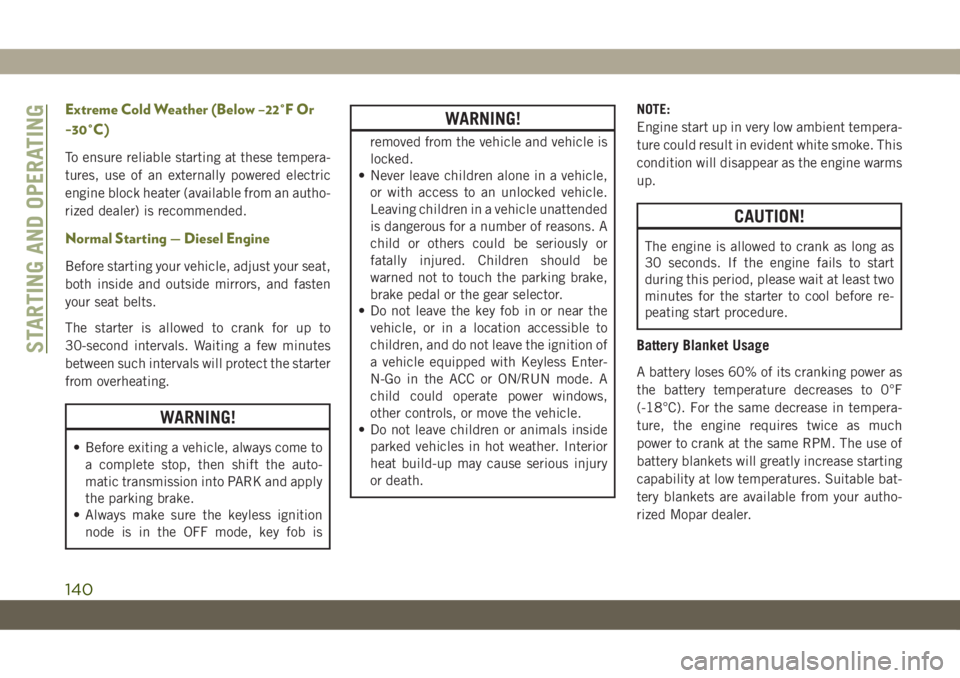
Extreme Cold Weather (Below –22°F Or
−30°C)
To ensure reliable starting at these tempera-
tures, use of an externally powered electric
engine block heater (available from an autho-
rized dealer) is recommended.
Normal Starting — Diesel Engine
Before starting your vehicle, adjust your seat,
both inside and outside mirrors, and fasten
your seat belts.
The starter is allowed to crank for up to
30-second intervals. Waiting a few minutes
between such intervals will protect the starter
from overheating.
WARNING!
• Before exiting a vehicle, always come to
a complete stop, then shift the auto-
matic transmission into PARK and apply
the parking brake.
• Always make sure the keyless ignition
node is in the OFF mode, key fob is
WARNING!
removed from the vehicle and vehicle is
locked.
• Never leave children alone in a vehicle,
or with access to an unlocked vehicle.
Leaving children in a vehicle unattended
is dangerous for a number of reasons. A
child or others could be seriously or
fatally injured. Children should be
warned not to touch the parking brake,
brake pedal or the gear selector.
• Do not leave the key fob in or near the
vehicle, or in a location accessible to
children, and do not leave the ignition of
a vehicle equipped with Keyless Enter-
N-Go in the ACC or ON/RUN mode. A
child could operate power windows,
other controls, or move the vehicle.
• Do not leave children or animals inside
parked vehicles in hot weather. Interior
heat build-up may cause serious injury
or death.NOTE:
Engine start up in very low ambient tempera-
ture could result in evident white smoke. This
condition will disappear as the engine warms
up.
CAUTION!
The engine is allowed to crank as long as
30 seconds. If the engine fails to start
during this period, please wait at least two
minutes for the starter to cool before re-
peating start procedure.
Battery Blanket Usage
A battery loses 60% of its cranking power as
the battery temperature decreases to 0°F
(-18°C). For the same decrease in tempera-
ture, the engine requires twice as much
power to crank at the same RPM. The use of
battery blankets will greatly increase starting
capability at low temperatures. Suitable bat-
tery blankets are available from your autho-
rized Mopar dealer.
STARTING AND OPERATING
140
Page 143 of 344
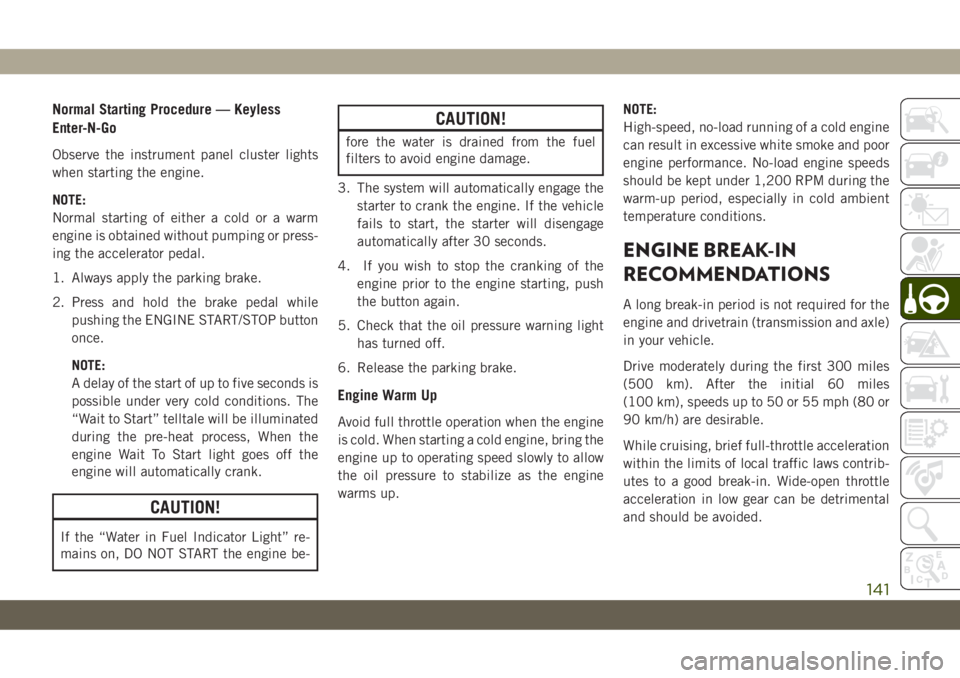
Normal Starting Procedure — Keyless
Enter-N-Go
Observe the instrument panel cluster lights
when starting the engine.
NOTE:
Normal starting of either a cold or a warm
engine is obtained without pumping or press-
ing the accelerator pedal.
1. Always apply the parking brake.
2. Press and hold the brake pedal while
pushing the ENGINE START/STOP button
once.
NOTE:
A delay of the start of up to five seconds is
possible under very cold conditions. The
“Wait to Start” telltale will be illuminated
during the pre-heat process, When the
engine Wait To Start light goes off the
engine will automatically crank.
CAUTION!
If the “Water in Fuel Indicator Light” re-
mains on, DO NOT START the engine be-
CAUTION!
fore the water is drained from the fuel
filters to avoid engine damage.
3. The system will automatically engage the
starter to crank the engine. If the vehicle
fails to start, the starter will disengage
automatically after 30 seconds.
4. If you wish to stop the cranking of the
engine prior to the engine starting, push
the button again.
5. Check that the oil pressure warning light
has turned off.
6. Release the parking brake.
Engine Warm Up
Avoid full throttle operation when the engine
is cold. When starting a cold engine, bring the
engine up to operating speed slowly to allow
the oil pressure to stabilize as the engine
warms up.NOTE:
High-speed, no-load running of a cold engine
can result in excessive white smoke and poor
engine performance. No-load engine speeds
should be kept under 1,200 RPM during the
warm-up period, especially in cold ambient
temperature conditions.
ENGINE BREAK-IN
RECOMMENDATIONS
A long break-in period is not required for the
engine and drivetrain (transmission and axle)
in your vehicle.
Drive moderately during the first 300 miles
(500 km). After the initial 60 miles
(100 km), speeds up to 50 or 55 mph (80 or
90 km/h) are desirable.
While cruising, brief full-throttle acceleration
within the limits of local traffic laws contrib-
utes to a good break-in. Wide-open throttle
acceleration in low gear can be detrimental
and should be avoided.
141
Page 149 of 344
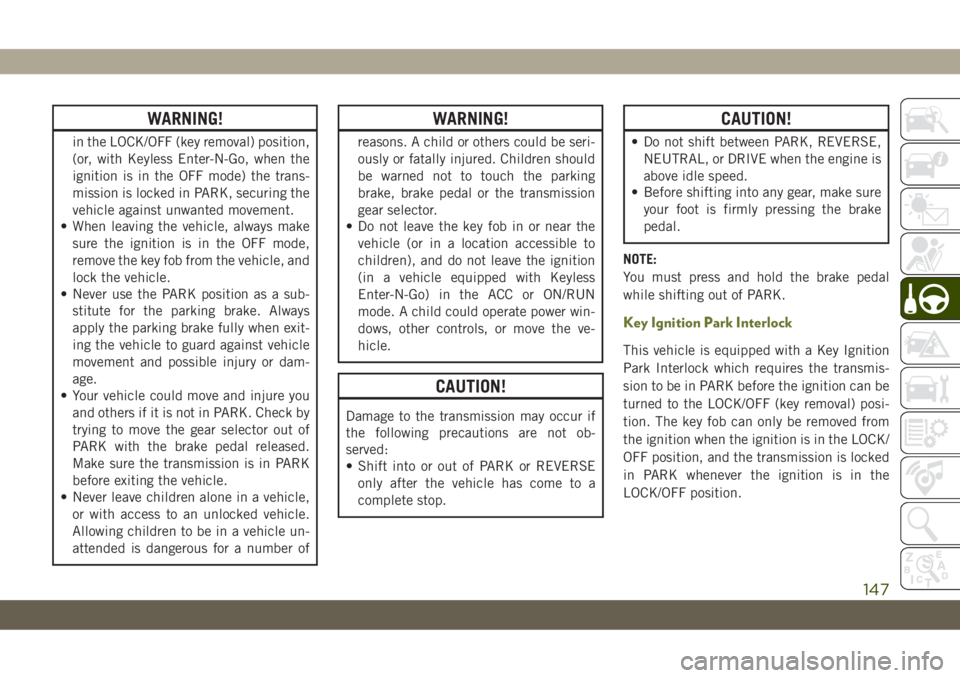
WARNING!
in the LOCK/OFF (key removal) position,
(or, with Keyless Enter-N-Go, when the
ignition is in the OFF mode) the trans-
mission is locked in PARK, securing the
vehicle against unwanted movement.
• When leaving the vehicle, always make
sure the ignition is in the OFF mode,
remove the key fob from the vehicle, and
lock the vehicle.
• Never use the PARK position as a sub-
stitute for the parking brake. Always
apply the parking brake fully when exit-
ing the vehicle to guard against vehicle
movement and possible injury or dam-
age.
• Your vehicle could move and injure you
and others if it is not in PARK. Check by
trying to move the gear selector out of
PARK with the brake pedal released.
Make sure the transmission is in PARK
before exiting the vehicle.
• Never leave children alone in a vehicle,
or with access to an unlocked vehicle.
Allowing children to be in a vehicle un-
attended is dangerous for a number of
WARNING!
reasons. A child or others could be seri-
ously or fatally injured. Children should
be warned not to touch the parking
brake, brake pedal or the transmission
gear selector.
• Do not leave the key fob in or near the
vehicle (or in a location accessible to
children), and do not leave the ignition
(in a vehicle equipped with Keyless
Enter-N-Go) in the ACC or ON/RUN
mode. A child could operate power win-
dows, other controls, or move the ve-
hicle.
CAUTION!
Damage to the transmission may occur if
the following precautions are not ob-
served:
• Shift into or out of PARK or REVERSE
only after the vehicle has come to a
complete stop.
CAUTION!
• Do not shift between PARK, REVERSE,
NEUTRAL, or DRIVE when the engine is
above idle speed.
• Before shifting into any gear, make sure
your foot is firmly pressing the brake
pedal.
NOTE:
You must press and hold the brake pedal
while shifting out of PARK.
Key Ignition Park Interlock
This vehicle is equipped with a Key Ignition
Park Interlock which requires the transmis-
sion to be in PARK before the ignition can be
turned to the LOCK/OFF (key removal) posi-
tion. The key fob can only be removed from
the ignition when the ignition is in the LOCK/
OFF position, and the transmission is locked
in PARK whenever the ignition is in the
LOCK/OFF position.
147
Page 338 of 344

Introduction...................1
Inverter
Power....................60
Jacking And Tire Changing........196
Jack Location................196
Jack Operation............196, 239
Jump Starting................209
Key Fob
Arm The System.............19
Disarm The System............19
Keyless Enter-N-Go..............20
Passive Entry...............20
Keys.......................13
Replacement...............15
LaneSense..................170
Lap/Shoulder Belts.............101
Latches....................138
Hood....................53
Leaks, Fluid.................138
Life Of Tires.................242
Liftgate.....................54
Closing...................56
Hands-Free................56
Opening..................54Light Bulbs..................138
Lights.....................138
AirBag ............64, 109, 137
Automatic Headlights..........34
Automatic High Beam..........34
Brake Assist Warning...........83
Brake Warning...............65
Bulb Replacement...........184
Cruise...............73, 74, 75
Daytime Running.............33
Engine Temperature Warning......66
Exterior..................138
Fog ...................36, 72
High Beam..............32, 34
High Beam/Low Beam Select......34
Hill Descent Control Indicator.....85
Lights On Reminder...........35
Low Fuel..................69
Malfunction Indicator
(Check Engine)..............69
Park
..................34, 73
Passing...................34
Seat Belt Reminder...........64
Security Alarm..............68
Service..................184
Tire Pressure Monitoring (TPMS)....94
Traction Control..............83Turn Signals..........36, 73, 138
Warning Instrument Cluster
Descriptions.............66, 73
Low Tire Pressure System..........94
Luggage Carrier................60
Lug Nuts...................253
Maintenance Free Battery.........234
Maintenance Schedule...........218
Malfunction Indicator Light
(Check Engine)...............69
Manual Transmission........144, 233
Fluid Level Check............233
Lubricant Selection...........265
Shift Speeds...............145
Media Hub..................289
Memory Feature (Memory Seats) . . .23, 25
Memory Seat..................23
Memory Seats And Radio..........23
Methanol...................255
Methanol Fuel................255
Mirrors.....................32
Modifications/Alterations
Vehicle....................4
Monitor, Tire Pressure System.......94
Mopar Accessories.............265
MP3 Control.................289
INDEX
336
Page 339 of 344
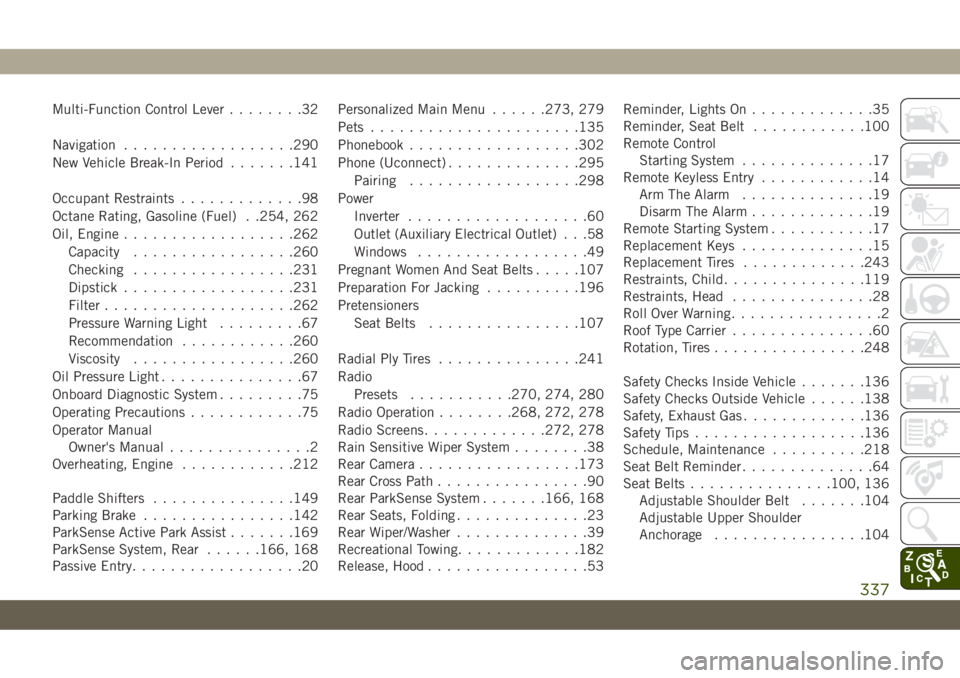
Multi-Function Control Lever........32
Navigation..................290
New Vehicle Break-In Period.......141
Occupant Restraints.............98
Octane Rating, Gasoline (Fuel) . .254, 262
Oil, Engine..................262
Capacity.................260
Checking.................231
Dipstick..................231
Filter....................262
Pressure Warning Light.........67
Recommendation............260
Viscosity.................260
Oil Pressure Light...............67
Onboard Diagnostic System.........75
Operating Precautions............75
Operator Manual
Owner's Manual...............2
Overheating, Engine............212
Paddle Shifters...............149
Parking Brake................142
ParkSense Active Park Assist.......169
ParkSense System, Rear......166, 168
Passive Entry..................20Personalized Main Menu......273, 279
Pets......................135
Phonebook..................302
Phone (Uconnect)..............295
Pairing..................298
Power
Inverter...................60
Outlet (Auxiliary Electrical Outlet) . . .58
Windows..................49
Pregnant Women And Seat Belts.....107
Preparation For Jacking..........196
Pretensioners
Seat Belts................107
Radial Ply Tires...............241
Radio
Presets...........270, 274, 280
Radio Operation........268, 272, 278
Radio Screens............
.272, 278
Rain Sensitive Wiper System........38
Rear Camera.................173
Rear Cross Path................90
Rear ParkSense System.......166, 168
Rear Seats, Folding..............23
Rear Wiper/Washer..............39
Recreational Towing.............182
Release, Hood.................53Reminder, Lights On.............35
Reminder, Seat Belt............100
Remote Control
Starting System..............17
Remote Keyless Entry............14
Arm The Alarm..............19
Disarm The Alarm.............19
Remote Starting System...........17
Replacement Keys..............15
Replacement Tires.............243
Restraints, Child...............119
Restraints, Head...............28
Roll Over Warning................2
Roof Type Carrier...............60
Rotation, Tires................248
Safety Checks Inside Vehicle.......136
Safety Checks Outside Vehicle......138
Safety, Exhaust Gas.............136
Safety Tips..................136
Schedule, Maintenance..........218
Seat Belt Reminder..............64
Seat Belts...............100, 136
Adjustable Shoulder Belt.......104
Adjustable Upper Shoulder
Anchorage................104
337